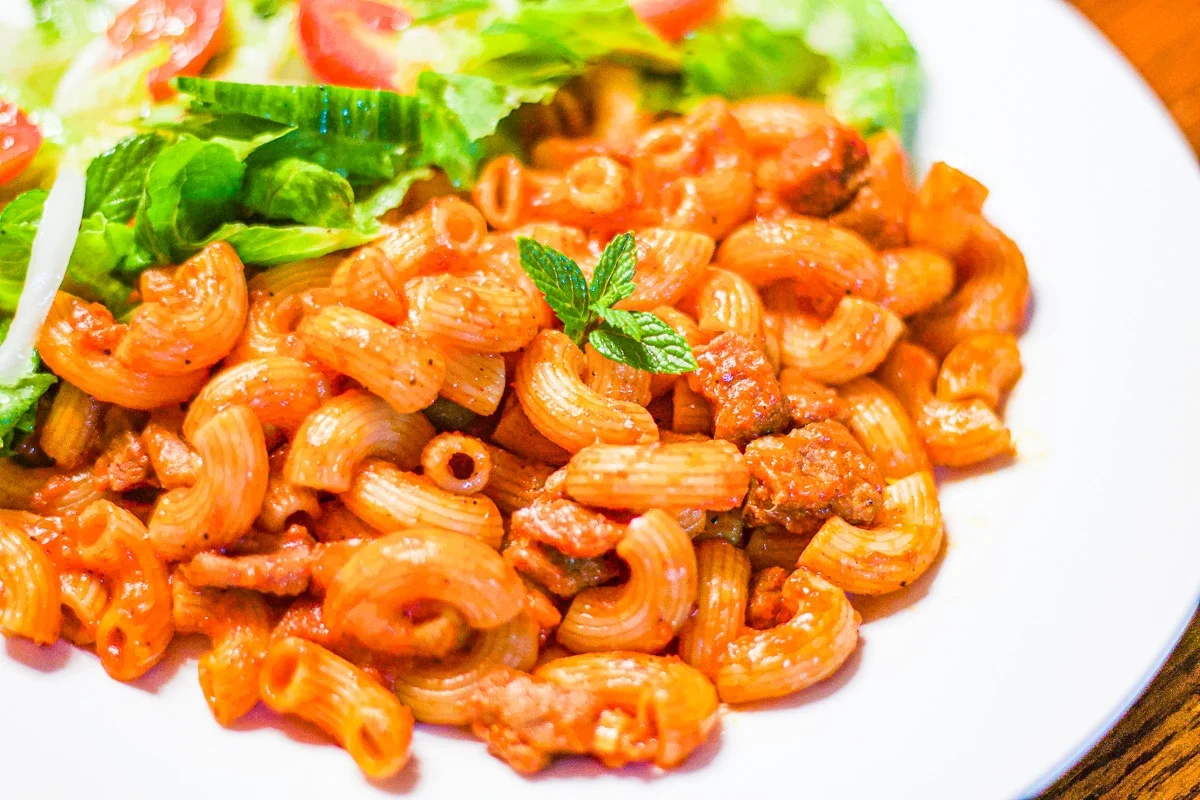Macaroni or Macaroni pasta is pasta shaped like narrow tubes. Made with durum wheat, macaroni is commonly cut in short lengths; curved macaroni is usually referred to as elbow macaroni.
Some home machines can produce macaroni shapes but, like most pasta, macaroni is usually made commercially by large-scale extrusion. The curved shape is made by different speeds of extrusion on opposite sides of the pasta tube as it comes out of the machine.

The term macaroni is often used synonymously with elbow-shaped macaroni, as it is the variety most often used in macaroni and cheese recipes. In Italy and other countries, the noun maccheroni can refer to straight, tubular, square-ended pasta corta (lit. ’short pasta’) or long pasta dishes, as in maccheroni alla chitarra and frittata di maccheroni, which are prepared with long pasta such as spaghetti.
In the US, federal regulations define three different shapes of dried pasta, such as spaghetti, as a “macaroni product”.
Etymology
In Italian, maccheroni refers to elongated pasta, not really in tabular form. This general meaning is still retained outside Rome and in different languages which borrowed the word.
Maccheroni emanates from Italian maccheroni (Italian: [makkeˈroːni]), plural form of maccherone. The academic consensus supports the position that the word is derived from the Greek μακαρία (makaría), a kind of barley broth which was served to commemorate the dead.
In turn, that comes from μάκαρες (mákares), meaning the ‘blessed ones, blessed dead’, the plural of μάκαρ (mákar), which means ‘blessed, happy’; μακάριος (makários, from μάκαρ (mákar) + -ιος (-ios, adjective suffix)) and Μακάριος (Makários), ‘Makarios’ (Latinized form: Macarius), are derived terms.
The many varieties sometimes differ from each other because of the texture of each pasta: rigatoni and tortiglioni, for instance, have ridges down their lengths, while chifferi, lumache, lumaconi, pipe, pipette, etc. refer to elbow-shaped pasta similar to macaroni in North American culture.
However, the Italian linguist G. Alessio argues that the word can have dual origins. The initial is the Medieval Greek μακαρώνεια (makarṓneia), ‘dirge’ (stated in sec. XIII by James of Bulgaria), which would mean ‘funeral meal’ and then ‘food to serve’ during this office (see modern Eastern Thrace’s μαχαρωνιά (makharōniá) – macharōnia in the sense of ‘rice-based dish served at the funeral’), in which case, the term would be composed of the double root of μακάριος (makários), ‘blessed’, and αἰωνίως (aiōníōs), ‘eternally’. The second is the Greek μακαρία (makaría), ‘barley broth’, which would have added the suffix -one.
In his book Delizia! The Epic History of Italians and their Food (2007), John Dickie instead says that the word macaroni, and its earlier variants such as maccheroni, “comes from maccare, meaning to pound or crush”.
The word first appears in English as makerouns in the 1390 The Forme of Cury, which records the earliest recipe for macaroni and cheese. The word later came to be applied to overdressed dandies and was associated with foppish Italian fashions of dress and periwigs, as in the eighteenth-century British song “Yankee Doodle”.
Cooking Direction
1. Prepare pasta according to package directions, drain and rinse with cold water until pasta is no longer warm.
2. In a large bowl, mix pasta, red peppers, onion, garlic, sweet pickles, cheese and celery.
3. In a small bowl, mix mustard, pepper, salt, milk, and mayo, mix well.
4. Pour dressing over pasta, and toss well to coat.
5. Add eggs and toss to combine.
6. Chill for 4 – 24 hours before serving. Keep leftovers in the refrigerator, covered.
Ingredients
2 cups elbow macaroni
1⁄2 cup celery, thinly sliced
1 red bell pepper, finely chopped
tablespoons red onions, finely chopped
1 garlic clove, minced
3⁄4 cup mayonnaise
1⁄4 cup sweet pickle, finely chopped
1 tablespoon milk
2 tablespoons Dijon mustard
1⁄4 teaspoon kosher salt
3⁄4 cup sharp cheddar cheese, cut into small cubes
3 hard-boiled eggs, coarsely chopped
1⁄4 teaspoon black pepper
One of the earliest varieties of pasta, macaroni is made from durum wheat and is shaped in short tubes with holes down the middle.
Although artisanal brands may be produced by hand using traditional methods, commercial varieties are made using state-of-the-art pasta machines. Other forms of macaroni include elbow macaroni (short and curved) and macaronicini (small shapes).


Leave a Reply